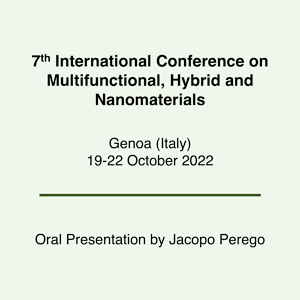Genoa (Italy), 19-22 October 2022, Oral Presentation by Jacopo Perego
Title: “Porous Polymeric and Hybrid Nanoparticles designed for Luminescent Materials and Scintillators”
Authors: J. Perego, C. X. Bezuidenhout, M. Orfano, F. Cova, S. Bracco, A. Vedda, A. Monguzzi, C. Dujardin, P. Sozzani and A. Comotti
Abstract
Porous materials provide a versatile and robust platform for the development of optical materials with unique photonic and scintillating properties. The rigid and directional connectivity of the frameworks allows for the effective inclusion of a high density of organic cromophores avoiding aggregation issues, while the precise spatial arrangement governs the intermolecular interactions between emitting moieties. Highly porous emitting framework (PEF) nanoparticles comprising diphenylanthracene moieties were generated by Yamamoto-type Ullmann coupling reaction[1]. The nanoparticles display a surface area of 680 m2 g-1 and excellent emission properties with a photoluminescence quantum yield ~ 0.70 and decay time of 3.9 ns. The effective inclusion of a porphyrin sensitizer through the accessible porosity generates self-standing sensitized triplet-triplet annihilation (sTTA) upconverters with upconversion quantum yield as high as 0.15, a record value for solid-state materials. We propose nanocrystalline MOFs based on zirconium oxy-hydroxy clusters as fast scintillators. The MOFs nanocrystals with diphenylanthracene ligands display photoluminescence quantum yield up to 0.64 ± 0.09 and high radioluminescence and scintillation under high-energy excitations. The encapsulation of nanocrystals with 50 nm size generates innovative composite fast scintillators with high light yield and fast time response and an ultrafast scintillation rise time of ~ 50 ps[2]. The co-assembly of two conjugated luminescent ligands with complementary absorption and emission properties in Zr-MOFs shows effective non-radiative energy transfer, allowing for fast exciton diffusion and fast emission with large Stokes shift (~ 6000 cm-1) which inhibites re-absorption processes. Notably, the MOF inclusion in a continuous polymeric matrix provides enhanced scintillating properties compared with the homo-ligand nanocrystals[3]. [1] Advanced Materials, 2019, 31, 1903309. [2] Nature Photonics, 2021,15, 393-400. [3] Nature Communications, ASAP.

